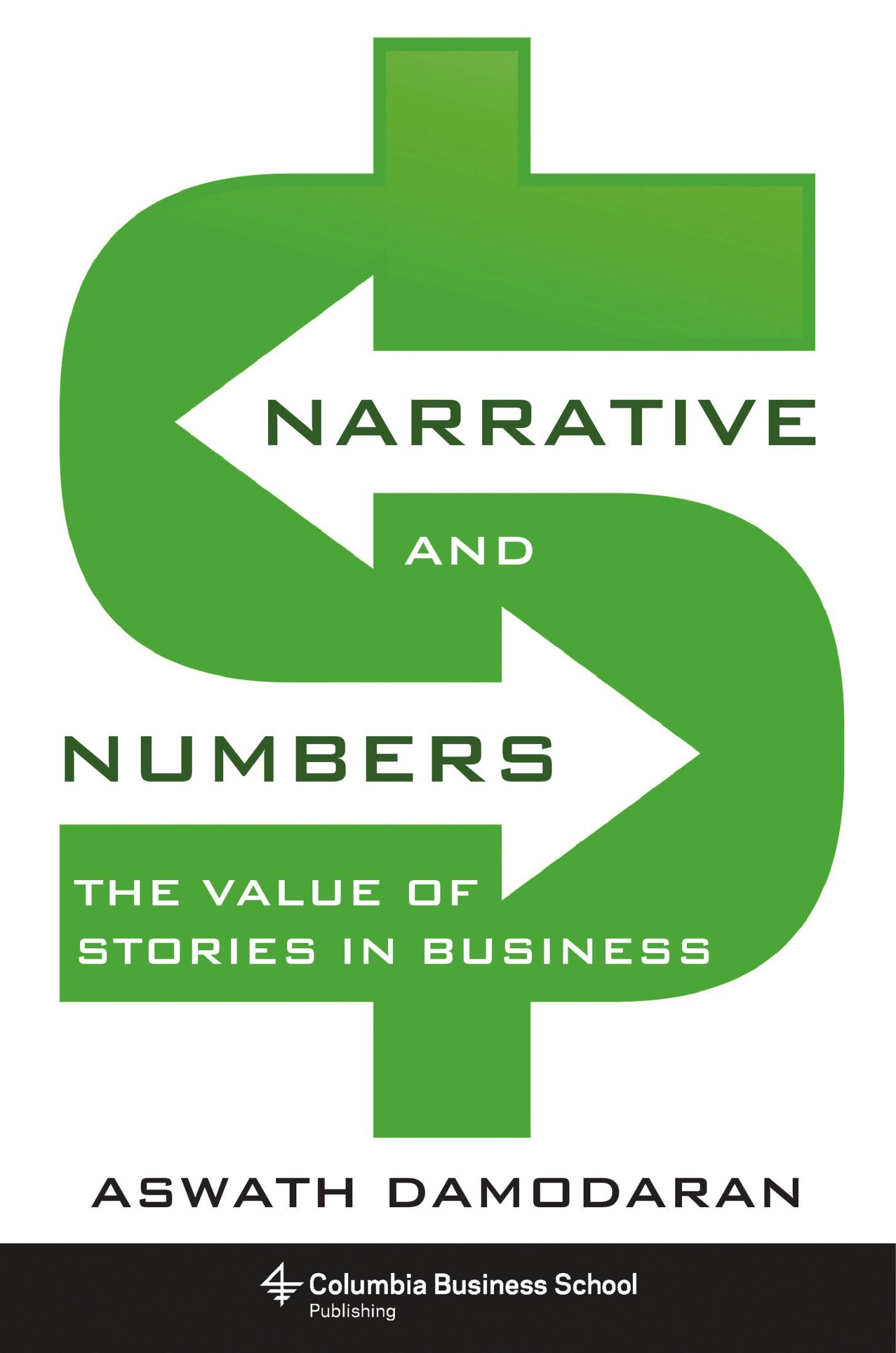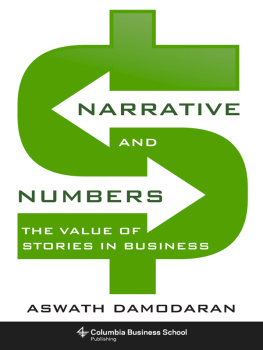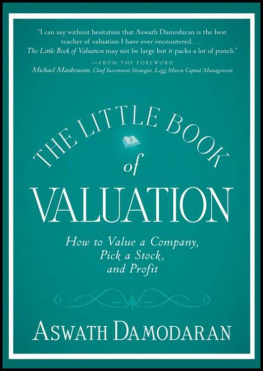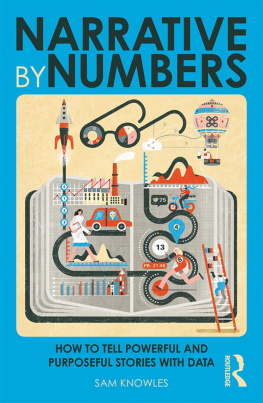Table of Contents
NARRATIVE AND NUMBERS
Columbia University Press
Publishers Since 1893
New York Chichester, West Sussex
cup.columbia.edu
Copyright 2017 Aswath Damodaran
All rights reserved
E-ISBN 978-0-231-54274-6
ISBN 978-0-231-18048-1 (cloth : alk. paper)
ISBN 978-0-231-54274-6 (e-book)
Cataloging-in-Publication Data is on file at the Library of Congress.
A Columbia University Press E-book.
CUP would be pleased to hear about your reading experience with this e-book at .
Cover design: Diane Luger
Cover image: Dollar Photo Club/Jalees & Smith
CONTENTS
As early as middle school, the world divides us into storytellers and number crunchers, and once divided, we stay in our preferred habitats. The numbers people seek out numbers classes in school, go on to numbers disciplines in college (engineering, physical sciences, accounting), and over time lose their capacity for storytelling. The storytellers populate the social science classes in school and then burnish their skills by becoming history, literature, philosophy, and psychology majors. Each group learns to both fear and be suspicious of the other, and by the time they come into my valuation class as MBA students, that suspicion has deepened into a divide that seems unbridgeable. You have two tribes, each one speaking its own language and each convinced that it has a monopoly on the truth and that the other side is the one that is wrong.
I must confess that I am more a numbers person than a storyteller and that when I first started teaching valuation, I catered almost entirely to those of my ilk. As I have wrestled with valuation questions, one of the most important lessons I have learned is that a valuation that is not backed up by a story is both soulless and untrustworthy and that we remember stories better than spreadsheets. While it did not come naturally to me, I started to animate my valuations with stories, and I have rediscovered the storytelling side that I had suppressed since sixth grade. While I am still instinctively a left-brainer, I have in a sense rediscovered my right brain. It is this experience of tying stories to numbers (or vice versa) that I have tried to bring into this book.
On a personal note, this is my first book written in the first-person singular. While you might find the repeated use of I and my off-putting and perhaps an indication of an outsized ego, I realized as I was writing about my valuations of individual companies that the stories that I was telling about those companies were my stories, reflecting not only what I thought about them and their managers but also my reading of the landscape. Thus, I will describe my attempts to tell stories about Alibaba in 2013, Amazon and Uber in 2014, and Ferrari in 2015, and to convert these stories into valuations. Rather than use the royal we and force you, as readers, to adopt my stories, I felt it would be much more honest (and more fun) to let you pick apart my stories and disagree with them. In fact, you can put this book to best use by taking my story about a company, say Uber, thinking about what parts of my story you disagree with, coming up with your story, and then valuing that company based on your story. A related peril of laying bare my narratives on real companies is that the real world will deliver surprises that will make each of my narratives wrong, sometimes horrendously so, over time. Rather than be scared of that prospect, I welcome it, since it will allow me to revisit my stories and improve and enrich them.
I will try to wear many hats in this book. I will, of course, spend a great deal of time looking at companies as an investor from the outside and valuing them, since that is the role that I most frequently play. I will sometimes play the role of an entrepreneur or founder trying to convince investors, customers, and potential employees of the viability and value of a new business. Since I have not founded or built any multibillion-dollar companies, you may not find me convincing, but there is perhaps something of value that I can offer. In the last few chapters, I will even look at the connection between storytelling and number crunching through the eyes of top managers of publicly traded companies, with the admission again that I have not been a CEO of a company in my lifetime.
If I accomplish my objectives, a number cruncher reading this book should be able to use my template to build a narrative to back his or her valuation of a company and a storyteller should just as easily be able to take a story, no matter how creative, and convert it into numbers. More generally, I hope that the book becomes a bridge between the two tribes (storytellers and number crunchers), giving them a common language and making them both better at what they do.
What comes more naturally to you, storytelling or number crunching? It is a question that I start my valuation classes with, and for most of us the answer usually comes easily, because in this age of specialization, we are forced to choose between telling stories and working with numbers early in our lives, and once that choice is made, we spend years not only increasing our skills in that chosen area but also ignoring the other. If you buy into the common wisdom of the left brain governing logic and numbers and the right brain controlling intuition, imagination, and creativity, we are using only half our brains in our daily lives. I think that we can become better at using our brains, if we can start working on the side that we have let lie dormant for so long.
A Simple Test
I know it is early in the book to be doing a valuation, but lets assume that I showed you a valuation of Ferrari, the legendary luxury auto company, at the time of its initial public offering. Lets assume that this valuation takes the form of a spreadsheet with forecasted revenues, operating income, and cash flows and that the key assumptions are presented as numbers. I tell you that I expect Ferraris revenues to grow 4 percent a year for the next five years, before dropping down to the growth rate of the economy; that the pretax operating margin will be 18.2 percent; and that the company will be able to generate 1.42 in revenues for every 1 it invests in the business. If you are not a numbers person, you are probably already lost, and even if you are, it is unlikely that you will remember the numbers for long.
Consider an alternative. I could tell you that I see Ferrari as a maker of luxury automobiles that can charge astronomically high prices for its cars and earn huge profit margins because it keeps its cars scarce and available only to an exclusive club of the very wealthy. That story is more likely to be remembered, but without specifics, it tells you little about how much you should be willing to pay for the company.
There is a third option, where I tie the low revenue growth (4 percent) to Ferraris need to maintain its exclusivity, with that same exclusivity allowing it to generate its huge profit margins and maintain stable earnings over time, since those who buy Ferraris are so wealthy they are unaffected by the ebbs and flows of the economy that affect other automakers. By tying my numbers to a story about the company, I not only ground my numbers but also provide a forum for you to offer your own story for Ferrari, which will then yield a different set of numbers and a different value for the company. That, in a nutshell, is the endgame for this book.











